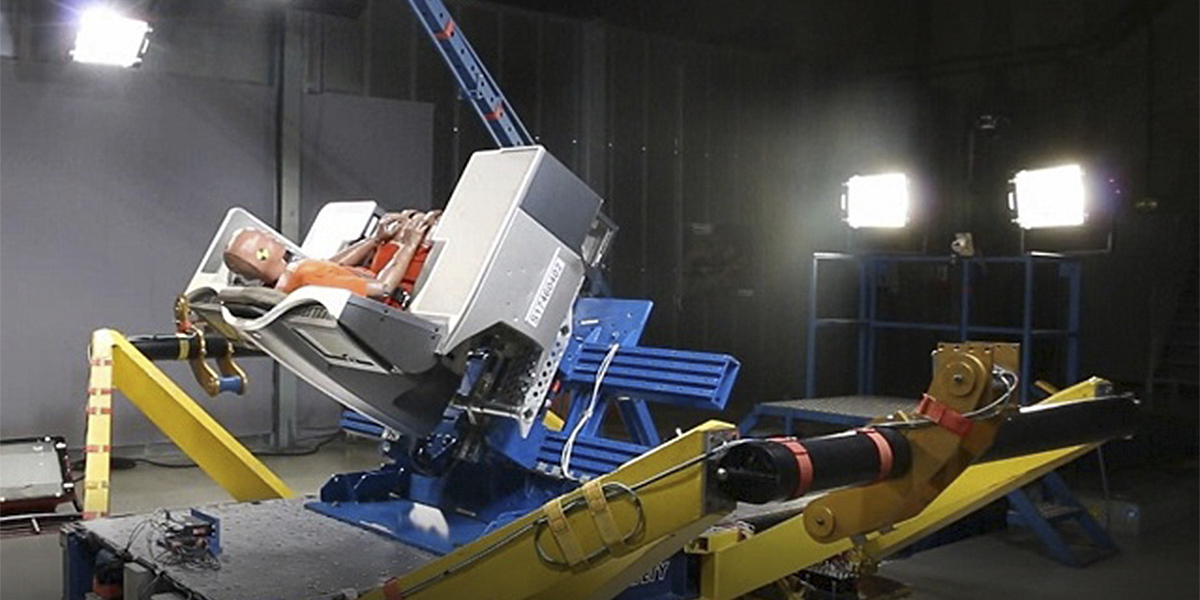DIN EN 14572 Pedestrian Airbag Deployment Crash Testing
The DIN EN 14572 standard outlines the requirements and methods for conducting crash testing to evaluate pedestrian airbag deployment. This crucial test is a mandatory requirement in automotive design, ensuring that vehicles are equipped with effective pedestrian protection systems.
Automotive manufacturers strive to enhance passenger safety by integrating advanced passive safety features into their designs. One such feature is the pedestrian airbag, which deploys during certain crash scenarios to mitigate the impact on pedestrians. The DIN EN 14572 test ensures that these systems are not only present but also functional and effective.
The standard specifies a series of controlled crash tests designed to simulate real-world conditions under which pedestrian airbags should deploy. These tests are conducted in an ISO-accredited laboratory using sophisticated crash testing equipment. The methodology involves the use of a standardized dummy representing an adult pedestrian, placed at various positions around the vehicle, and subjected to controlled impacts.
The test setup includes a vehicle equipped with pedestrian airbags, a crash barrier, and a control system that ensures precise impact conditions. A series of tests are conducted under different scenarios to evaluate the performance of the airbag in deploying appropriately during the impact. This includes assessing the timing, force distribution, and coverage area of the deployed airbag.
After each test, detailed data is collected from various sensors and cameras positioned around the crash setup. These readings include the deployment speed, force exerted by the airbag, and the position at which it deploys. The data is analyzed to ensure compliance with DIN EN 14572 requirements.
Compliance with this standard is critical for automotive manufacturers as it ensures that their vehicles meet regulatory standards and can be sold in markets where pedestrian safety is a priority. Non-compliance not only risks penalties but also undermines public trust in the manufacturer's commitment to safety.
The importance of this test cannot be overstated, especially given the increasing number of pedestrian fatalities globally. By adhering to DIN EN 14572, manufacturers contribute to reducing these statistics by ensuring that their vehicles are equipped with effective pedestrian protection systems.
Scope and Methodology
The scope of DIN EN 14572 covers the testing procedures for pedestrian airbag deployment. The methodology involves setting up a controlled crash test environment where various parameters can be precisely adjusted to simulate real-world conditions. This includes adjusting the speed, angle, and position of impact.
The dummy used in these tests is designed to mimic an adult pedestrian's body structure. It is equipped with sensors that measure key metrics such as force distribution, deployment speed, and coverage area. The test setup also includes a range of cameras positioned around the crash barrier to capture detailed footage of the deployment process.
During each test, the vehicle undergoes controlled impacts at predetermined speeds and angles. The dummy is placed in various positions relative to the vehicle to simulate different pedestrian impact scenarios. After each test, data is collected from sensors and cameras for analysis. This includes measurements of the force exerted by the airbag, its deployment speed, and coverage area.
The methodology also involves analyzing the results against DIN EN 14572 standards. Compliance with these standards ensures that the pedestrian airbags deployed effectively during the test. The data collected is crucial for refining the design and improving the performance of future models.
Why Choose This Test
Selecting DIN EN 14572 Pedestrian Airbag Deployment Crash Testing offers several advantages to automotive manufacturers. Firstly, compliance with this standard ensures that vehicles meet regulatory requirements in markets where pedestrian safety is a priority.
The test provides valuable insights into the performance of pedestrian airbags under various impact conditions. This information can be used to refine and improve the design of future models, enhancing overall vehicle safety. Additionally, successful completion of these tests enhances brand reputation and customer confidence.
Manufacturers who choose this test demonstrate their commitment to public safety. By adhering to DIN EN 14572, they ensure that their vehicles are equipped with effective pedestrian protection systems, reducing the risk of injury during accidents involving pedestrians.
The detailed data collected from these tests can also be used for research and development purposes. This information helps manufacturers identify areas for improvement in passive safety features, leading to safer vehicles in the future.
International Acceptance and Recognition
DIN EN 14572 is widely recognized and accepted across Europe and other regions with stringent pedestrian safety regulations. This standard ensures that automotive manufacturers meet international standards for pedestrian protection, enhancing compliance and market access.
The DIN EN 14572 test procedure is designed to simulate real-world conditions as closely as possible. This approach allows for accurate assessment of pedestrian airbag performance under various impact scenarios. By adhering to this standard, manufacturers can ensure that their vehicles meet regulatory requirements in multiple markets, facilitating easier market entry and broader consumer appeal.
The international acceptance of DIN EN 14572 also contributes to enhanced public safety by promoting the use of effective pedestrian protection systems. As more manufacturers adopt these testing procedures, the overall level of safety on roads improves, reducing the risk of pedestrian injuries during accidents.





